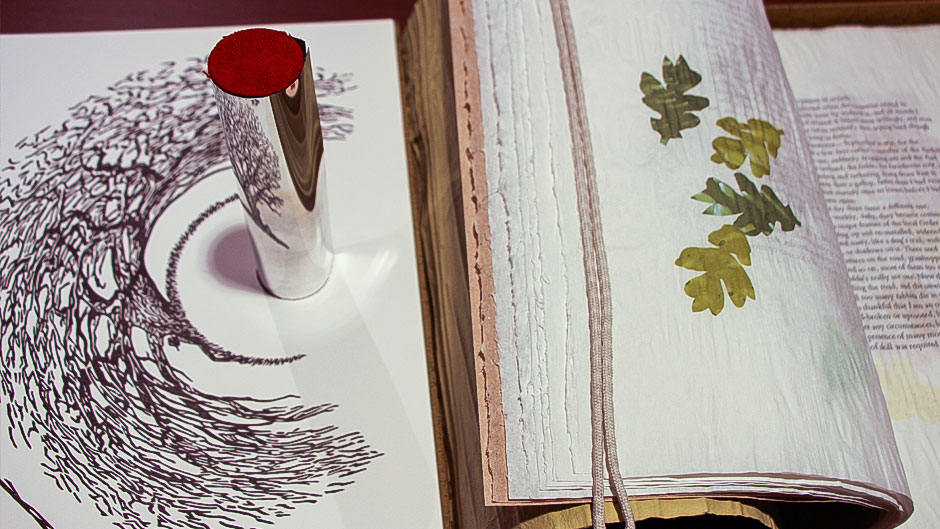Martin Casuso’s “Check Memory” is one of 16 student artist’s books that will be displayed as part of the rotating installation in the Ashe Building lobby. A University of Miami graduate student at the time he created the book, today Casuso is the building facilities coordinator at the Lowe Art Museum.
Casuso’s book and most others in the collection were inspired by a course taught by Cristina Favretto, head of Special Collections at University Libraries, which explored the evolution of the book and bookmaking. As part of the collaborative course, students viewed artist’s books from the library’s extensive collection of these unique multimedia books—and were invited to modulate their personal inspiration into their own book.
“Everything that I used in creating the book had some tie to my nostalgic past or directly to my mother,” Casuso pointed out. As a young boy growing up in Miami, he explained, he would often accompany his Dutch mother to the store where, as was then common practice, she would write paper checks to pay for everything—from gas to hardware to groceries.
“When I looked at her old checks years after she died, it was easy for me to conjure memories of all those specific places we had visited together,” he said.
For “Check Memory,” he scanned old checks and reduced them in size, laminated them for protection, fitted them into a cedar box with “Mom” notched in the wood, and bound them together with a leather strap salvaged from his mother’s luggage.
The text that he wrote to accompany his artist’s book was purposefully rough. “It’s meant to be like memory itself, rambling and informal—like a run-on sentence—that’s the inspiration I was trying to express,” Casuso said.
The Ashe Building installation includes two artist’s books at a time and 16 in total from students that will rotate in coming weeks as part of the display that highlights the unique medium of the artist’s book.
Favretto, whose History of the Book course inspired most of the pieces in the installation, sought to share her own growing fascination for the unique art form with students.
"These texts often don't look like our typical conception of a book,” Favretto said. “They can have unusual shapes, bindings, and typefaces—and can unfold like a game board or be housed inside a soccer ball. Their unusual and often quirky qualities help to enhance understanding of the story being told."
She cited the example of Ursula LeGuin’s “The Direction of the Road,” one of more than 1,000 artist’s books in the library’s collection.
"The special paper stock crackles when you turn the pages and makes a sound like leaves crunching under your feet,” Favretto noted. “The tree who ‘tells’ the story stands at a crossroads where it witnesses all sorts of things passing before it—and the special cylindrical device that comes with the book helps the reader see as the tree does.” This "anamorphic" style was used by Leonardo da Vinci and others, she explained.
In addition to the class she taught, a few professors in English, creative writing, and other subject areas have encouraged their students to attempt making an artist’s book, according to Favretto. And some students, with their own initiative, make and contribute them to the library’s collection.
“The beautiful thing when a student gives us an artist’s book is that it gets catalogued and put in a library collection,” she said. “They can then come back 20, 50 years from now and say, ‘I’ve got a book in this collection,’ ’’ she added.
“And for us in the library, we have a testament to the impact and demonstration of how people react to the materials we have,” Favretto continued. “It creates a nice dialogue between our collections and the generations of people viewing them—and they don’t have to be students to make an artist’s book.”
The books can use a wide range of materials, whatever the maker chooses to utilize. They’re inspired by other art and can be a homage to something or someone, but they are generally not that directly inspired, she indicated.
Arthur Dunkelman, curator of the library’s Jay I. Kislak Collection of the Early Americas, Exploration and Navigation, assisted in the installation.
“Conservation and creativity come together in real space for these books,” said Dunkelman, adding that some of the books are even anonymous and most of the students are not artists per se.
“They did the books for themselves,” he said. “They’re young people who have an insight into their lives and are willing to look at themselves in a fun and whimsical way. For me, it’s fascinating to look at them to try and understand what inspired them.”
 |
 |

